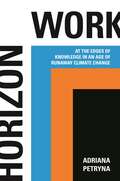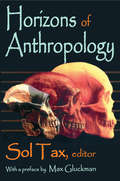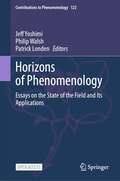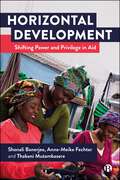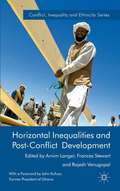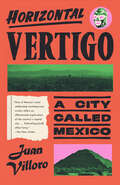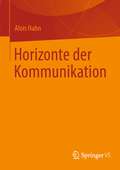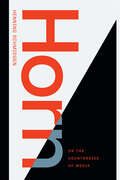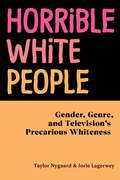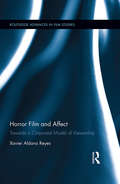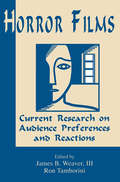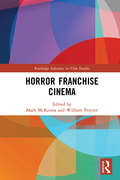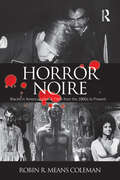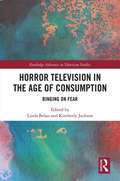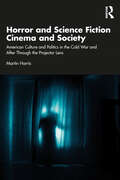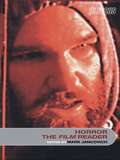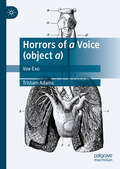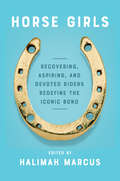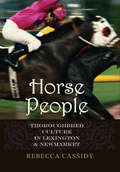- Table View
- List View
Horizon Work: At the Edges of Knowledge in an Age of Runaway Climate Change
by Adriana PetrynaA new way of thinking about the climate crisis as an exercise in delimiting knowable, and habitable, worldsAs carbon dioxide emissions continue to rise, Earth’s fragile ecosystems are growing increasingly unstable and unpredictable. Horizon Work explores how climate change is disrupting our fundamental ability to project how the environment will act over time, and how these rapidly faltering predictions are colliding with the dangerous new realities of emergency response.Anthropologist Adriana Petryna examines the climate crisis through the lens of “horizoning,” a mode of reckoning that considers unnatural disasters against a horizon of expectation in which people and societies can act. She talks to wildfire scientists who, amid chaotic fire seasons and shifting fire behaviors, are revising predictive models calibrated to conditions that no longer exist. Petryna tells the stories of wildland firefighters who could once rely on memory of previous fires to gauge the behaviors of the next. Trust in patterns has become an occupational hazard. Sometimes, the very concept of projection becomes untenable. Yet if all we see is doom, we will overlook something crucial about the scientific and ethical labor needed to hold back climate chaos. Here is where the work of horizoning begins.From experiments probing our planetary points of no return to disaster ecologies where the stark realities of climate change are being confronted, Horizon Work reveals how this new way of thinking has the power to reverse harmful legacies while turning voids where projection falters into spaces of collective action and recoverable futures.
Horizons of Anthropology
by Sol TaxThe scientific study of human evolution and culture is about a hundred years old. This volume surveys its achievements and methods. Originally published more than forty years ago, the volume's contributors include people who have shaped anthropology's future. As Gluckman says in his Preface, the contributions "point to the horizons of increasing understanding of man, his evolution and his social setting, as seen by a rising generation of scholars."The book includes chapters on how man gradually became different from other primates--on the origin and nature of language and its contribution to our peculiarities as human beings. It surveys the long history of human culture and societies and the theories about their similarities and differences; it discusses human equality and inequality, and it considers, from the anthropologist's point of view, economics, politics, law, religion, medicine, and the arts.In recent decades the various branches of anthropology--physical, cultural, psychological, and social--have become more specialized, and each branch is increasingly linking itself to its appropriate cognate, biological, psychological, or social sciences. Yet there remains a central common field to anthropology, as the science of man, for practitioners in all its branches. This book develops that common interest and deals with the specific problems of various parts of the field. The book brings out the basic nature of anthropology and the extraordinary fascination that lies in the systematic study of the exuberant variety of human societies and customs.
Horizons of Phenomenology: Essays on the State of the Field and Its Applications (Contributions to Phenomenology #122)
by Philip Walsh Jeff Yoshimi Patrick LondenThis is an open access book which explores phenomenology as both an exceptionally diverse movement in philosophy as well as an active research method that crosses disciplinary boundaries. The volume brings together lively overviews of major areas and schools of phenomenology, as well as the most recent applications across a range of fields. The first part reviews the state-of-the-art in various areas of contemporary phenomenology, including several distinct schools of Husserl and Heidegger scholarship, as well as approaches derived from Merleau-Ponty, de Beauvoir, Fanon, and others. An innovative quantitative analysis of citation networks provides rich visualizations of the field as a whole. The second part showcases phenomenology as a living discipline that can advance research in other areas. While some areas of interaction between phenomenology and other disciplines are by now well established (e.g. cognitive science), this volume sheds light on newer areas of application. The goal is to move beyond discussions of philosophical method and highlight scholars who are actually doing phenomenology in a variety of areas, including: Embodiment and questions of gender, race, and identity, The arts (visual art, literature, architecture), and Archaeology and anthropology. This volume offers a concise introduction to cutting edge phenomenological research and is suitable for both students and specialists.
Horizons: The World
by Houghton Mifflin HarcourtEvery one of you already holds the important office of citizen. Social studies will help you learn about citizenship. That is why social studies is important in your life."
Horizontal Development: Shifting Power and Privilege in Aid
by Anne-Meike Fechter Thabani Mutambasere Shonali BanerjeeAccessible and comprehensive, this book puts forth an innovative perspective on international aid, going beyond top-down attempts to centre local voices and practices. By providing an overview of newer iterations and overlooked practices in development, including citizen aid, technologies for development, and faith-based humanitarianism, the book explores the extent to which they disrupt existing models and potentially lead to more equitable grassroots-led approaches. The authors develop the concept of 'horizontal development' to examine how power and privilege operate in international and local horizontal development spaces. Examining challenges, they also highlight opportunities for doing things differently in light of prominent calls for decolonising aid and development.
Horizontal Europeanisation: The Transnationalisation of Daily Life and Social Fields in Europe (Routledge Advances in Sociology)
by Martin HeidenreichEuropean integration has transformed the social life of European citizens. Daily life and work no longer take place primarily in a local and national context, but increasingly in a European and transnational frame – a process of ‘horizontal Europeanisation’ which, while increasing the life chances of European citizens, also brings about conflicts among them. This book focuses on processes of Europeanisation in the academic, bureaucratic, professional and associational field, as well as on the Europeanisation of solidarity, networks and social inequalities. Drawing on detailed empirical studies and attending to the reinforcement of centre‐periphery structures in Europe, it analyses the dynamics of horizontal Europeanisation processes, highlighting the crucial role of national practices and perceptions in a transnational context, as well as the related conflicts between the winners and losers in this process. As such, it will appeal to scholars of sociology and political science with interests in European integration, social change and social stratification.
Horizontal Inequalities and Post-Conflict Development
by Frances Stewart Arnim Langer Rajesh VenugopalThis book evaluates the extent to which post-conflict reconstruction has addressed problems of horizontal inequalities through country case studies on Burundi, Rwanda, Nepal, Peru, Guatemala, Bosnia and Herzegovina, and Afghanistan, and four thematic studies on macro-economic policies, privatisation, PRSP's, and employment generation.
Horizontal Vertigo: A City Called Mexico
by Juan VilloroAt once intimate and wide-ranging, and as enthralling, surprising, and vivid as the place itself, this is a uniquely eye-opening tour of one of the great metropolises of the world, and its largest Spanish-speaking city. Horizontal Vertigo: The title refers to the fear of ever-impending earthquakes that led Mexicans to build their capital city outward rather than upward. With the perspicacity of a keenly observant flaneur, Juan Villoro wanders through Mexico City seemingly without a plan, describing people, places, and things while brilliantly drawing connections among them. In so doing he reveals, in all its multitudinous glory, the vicissitudes and triumphs of the city &’s cultural, political, and social history: from indigenous antiquity to the Aztec period, from the Spanish conquest to Mexico City today—one of the world&’s leading cultural and financial centers. In this deeply iconoclastic book, Villoro organizes his text around a recurring series of topics: &“Living in the City,&” &“City Characters,&” &“Shocks,&” &“Crossings,&” and &“Ceremonies.&” What he achieves, miraculously, is a stunning, intriguingly coherent meditation on Mexico City&’s genius loci, its spirit of place.
Horizonte der Kommunikation
by Alois HahnÜber Kommunikation ist viel kommuniziert worden. Watzlawick schreibt sogar, man könne nicht nicht kommunizieren. Die hier vorgelegte Aufsatzsammlung vereint eine Reihe von Beiträgen, die im Laufe der Jahre in höchst unterschiedlichen Kontexten entstanden sind. Das Thema Kommunikation war oft nicht das Zentrum. Viele Texte entstanden ursprünglich auch in interdisziplinären Kolloquien. Die Arbeiten hier zusammenzufügen entspringt der Absicht, eine vorher teilweise latente Sinnlinie freizulegen. Man könnte von einer Transformation von Publikationen in Spolien sprechen. Das Hauptanliegen ist, einige bislang eher wenig behandelte Horizonte des Themas ins Auge zu fassen, Ränder sozusagen oder Sonderaspekte. Dieser Horizont erscheint bisweilen als Kaleidoskop.
Horn, or The Counterside of Media (Sign, Storage, Transmission)
by Henning SchmidgenWe regularly touch and handle media devices. At the same time, media devices such as body scanners, car seat pressure sensors, and smart phones scan and touch us. In Horn, Henning Schmidgen reflects on the bidirectional nature of touch and the ways in which surfaces constitute sites of mediation between interior and exterior. Schmidgen uses the concept of "horn"—whether manifested as a rhinoceros horn or a musical instrument—to stand for both natural substances and artificial objects as spaces of tactility. He enters into creative dialogue with artists, scientists, and philosophers, ranging from Salvador Dalí, William Kentridge, and Rebecca Horn to Sigmund Freud, Walter Benjamin, and Marshall McLuhan, who plumb the complex interplay between tactility and technological and biological surfaces. Whether analyzing how Dalí conceived of images as tactile entities during his “rhinoceros phase” or examining the problem of tactility in Thomas Pynchon’s The Crying of Lot 49, Schmidgen reconfigures understandings of the dynamic phenomena of touch in media.
Horrible Mothers: Representations across Francophone North America
by Loïc BourdeauFor too long the main narratives of motherhood have been oppressive and exclusionary, frequently ignoring issues of female identity—especially regarding those not conforming to traditional female stereotypes. Horrible Mothers offers a variety of perspectives for analyzing representations of the mother in francophone literature and film at the turn of the twenty-first century in North America, including Québec, Ontario, New England, and California. Contributors reexamine the &“horrible mother&” paradigm within a broad range of sociocultural contexts from different locations to broaden the understanding of mothering beyond traditional ideology. The selections draw from long-established scholarship in women&’s studies as well as from new developments in queer studies to make sense of and articulate strategies of representation; to show how contemporary family models are constantly evolving, reshaping, and moving away from heteronormative expectations; and to reposition mothers as subjects occupying the center of their own narrative, rather than as objects. The contributors engage narratives of mothering from myriad perspectives, referencing the works of writers or filmmakers such as Marguerite Andersen, Nelly Arcan, Grégoire Chabot, Xavier Dolan, Nancy Huston, and Lucie Joubert.
Horrible Prettiness
by Robert C. AllenRobert Allen's compelling book examines burlesque not only as popular entertainment but also as a complex and transforming cultural phenomenon. When Lydia Thompson and her controversial female troupe of "British Blondes" brought modern burlesque to the United States in 1868, the result was electric. Their impertinent humor, streetwise manner, and provocative parodies of masculinity brought them enormous popular success--and the condemnation of critics, cultural commentators, and even women's rights campaigners.Burlesque was a cultural threat, Allen argues, because it inverted the "normal" world of middle-class social relations and transgressed norms of "proper" feminine behavior and appearance. Initially playing to respectable middle-class audiences, burlesque was quickly relegated to the shadow-world of working-class male leisure. In this process the burlesque performer "lost" her voice, as burlesque increasingly revolved around the display of her body.Locating burlesque within the context of both the social transformation of American theater and its patterns of gender representation, Allen concludes that burlesque represents a fascinating example of the potential transgressiveness of popular entertainment forms, as well as the strategies by which they have been contained and their threats defused.
Horrible White People: Gender, Genre, and Television's Precarious Whiteness
by Taylor Nygaard Jorie LagerweyExamines the bleak television comedies that illustrate the obsession of the white left with its own anxiety and sufferingAt the same time that right-wing political figures like Donald Trump were elected and reactionary socio-economic policies like Brexit were voted into law, representations of bleakly comic white fragility spread across television screens. American and British programming that featured the abjection of young, middle-class, liberal white people—such as Broad City, Casual, You’re the Worst, Catastrophe, Fleabag, and Transparent—proliferated to wide popular acclaim in the 2010s. Taylor Nygaard and Jorie Lagerwey track how these shows of the white left, obsessed with its own anxiety and suffering, are complicit in the rise and maintenance of the far right—particularly in the mobilization, representation, and sustenance of structural white supremacy on television.Nygaard and Lagerwey examine a cycle of dark television comedies, the focus of which are “horrible white people,” by putting them in conversation with similar upmarket comedies from creators and casts of color like Insecure, Atlanta, Dear White People, and Master of None. Through their analysis, they demonstrate the ways these non-white-centric shows negotiate prestige TV’s dominant aesthetics of whiteness and push back against the centering of white suffering in a time of cultural crisis.Through the lens of media analysis and feminist cultural studies, Nygaard and Lagerwey’s book opens up new ways of looking at contemporary television consumption—and the political, cultural, and social repercussions of these “horrible white people” shows, both on- and off-screen.
Horror (Routledge Film Guidebooks)
by Brigid CherryHorror cinema is a hugely successful, but at the same time culturally illicit genre that spans the history of cinema. It continues to flourish with recent cycles of supernatural horror and torture porn that span the full range of horror styles and aesthetics. It is enjoyed by audiences everywhere, but also seen as a malign influence by others. In this Routledge Film Guidebook, audience researcher and film scholar Brigid Cherry provides a comprehensive overview of the horror film and explores how the genre works. Examining the way horror films create images of gore and the uncanny through film technology and effects, Cherry provides an account of the way cinematic and stylistic devices create responses of terror and disgust in the viewer. Horror examines the way these films construct psychological and cognitive responses and how they speak to audiences on an intimate personal level, addressing their innermost fears and desires. Cherry further explores the role of horror cinema in society and culture, looking at how it represents various identity groups and engages with social anxieties, and examining the way horror sees, and is seen by, society.
Horror Film and Affect: Towards a Corporeal Model of Viewership (Routledge Advances in Film Studies)
by Xavier Aldana ReyesThis book brings together various theoretical approaches to Horror that have received consistent academic attention since the 1990s – abjection, disgust, cognition, phenomenology, pain studies – to make a significant contribution to the study of fictional moving images of mutilation and the ways in which human bodies are affected by those on the screen on three levels: representationally, emotionally and somatically. Aldana Reyes reads Horror viewership as eminently carnal, and seeks to articulate the need for an alternative model that understands the experience of feeling under corporeal threat as the genre’s main descriptor. Using recent, post-millennial examples throughout, the book also offers case studies of key films such as Hostel, [REC], Martyrs or Ginger Snaps, and considers contemporary Horror strands such as found footage or 3D Horror.
Horror Films: Current Research on Audience Preferences and Reactions (Routledge Communication Series)
by Iii James B. Weaver Ron TamburiniWhy do so many of us enjoy being told frightening stories? What are some of the consequences that result from such exposure? In light of the considerable popularity of horror films over the last three decades, these questions have become the focus of growing attention for many scholars. However, research on audience preferences for, and reactions to, horror films has been performed eclectically by investigators from varied theoretical and methodological backgrounds. As a result, the information has not been effectively integrated. This volume was written to address this problem and to position the study of audience responses to frightening fiction as a significant research topic.
Horror Franchise Cinema (Routledge Advances in Film Studies)
by Mark McKennaThis book explores horror film franchising from a broad range of interdisciplinary perspectives and considers the horror film’s role in the history of franchising and serial fiction. Comprising 12 chapters written by established and emerging scholars in the field, Horror Franchise Cinema redresses critical neglect toward horror film franchising by discussing the forces and factors governing its development across historical and contemporary terrain while also examining text and reception practices. Offering an introduction to the history of horror franchising, the chapters also examine key texts including Universal Studio monster films, Blumhouse production films, The Texas Chainsaw Massacre, A Nightmare on Elm Street, Alien, I Spit on Your Grave, Let the Right One In, Italian zombie films, anthology films, and virtual reality. A significant contribution to studies of horror cinema and film/media franchising from the 1930s to the present day, this book will be of interest to students and scholars of film studies, media and cultural studies, franchise studies, political economy, audience/reception studies, horror studies, fan studies, genre studies, production cultures, and film histories.
Horror Noire: Blacks in American Horror Films from the 1890s to Present
by Robin R Means ColemanFrom King Kong to Candyman, the boundary-pushing genre of the horror film has always been a site for provocative explorations of race in American popular culture. In Horror Noire: Blacks in American Horror Films from 1890's to Present, Robin R. Means Coleman traces the history of notable characterizations of blackness in horror cinema, and examines key levels of black participation on screen and behind the camera. She argues that horror offers a representational space for black people to challenge the more negative, or racist, images seen in other media outlets, and to portray greater diversity within the concept of blackness itself. Horror Noire presents a unique social history of blacks in America through changing images in horror films. Throughout the text, the reader is encouraged to unpack the genre’s racialized imagery, as well as the narratives that make up popular culture’s commentary on race. Offering a comprehensive chronological survey of the genre, this book addresses a full range of black horror films, including mainstream Hollywood fare, as well as art-house films, Blaxploitation films, direct-to-DVD films, and the emerging U.S./hip-hop culture-inspired Nigerian "Nollywood" Black horror films. Horror Noire is, thus, essential reading for anyone seeking to understand how fears and anxieties about race and race relations are made manifest, and often challenged, on the silver screen.
Horror Television in the Age of Consumption: Binging on Fear (Routledge Advances in Television Studies)
by Kimberly Jackson Linda BelauCharacterized as it is by its interest in and engagement with the supernatural, psycho-social formations, the gothic, and issues of identity and subjectivity, horror has long functioned as an allegorical device for interrogations into the seamier side of cultural foundations. This collection, therefore, explores both the cultural landscape of this recent phenomenon and the reasons for these television series’ wide appeal, focusing on televisual aesthetics, technological novelties, the role of adaptation and seriality, questions of gender, identity and subjectivity, and the ways in which the shows’ themes comment on the culture that consumes them. Featuring new work by many of the field’s leading scholars, this collection offers innovative readings and rigorous theoretical analyses of some of our most significant contemporary texts in the genre of Horror Television.
Horror and Science Fiction Cinema and Society: American Culture and Politics in the Cold War and After Through the Projector Lens
by Martin HarrisExamining how horror and science fiction films from the 1950s to the present invent and explore fictional “us-versus-them” scenarios, this book analyzes the different ways such films employ allegory and/or satire to interrogate the causes and consequences of increasing polarization in American politics and society.Starting with the killer ants film with an anti-communist subtext Them! (1954) and concluding with Jordan Peele’s social horror film with revenge-seeking homicidal doppelgängers Us (2019), Martin Harris highlights social and political contexts, contemporary reviews and responses, and retrospective evaluations to show how American horror and science fiction films reflect and respond to contemporary conflicts marking various periods in U.S. history from post-WWII to the present, including those concerning race, gender, class, faith, political ideology, national identity, and other elements of American society.Horror and Science Fiction Cinema and Society draws upon cinematic sociology to provide a resourceful approach to American horror and science fiction films that integrates discussion of plot construction and character development with analyses of the thematic uses of conflict, guiding readers’ understanding of how filmmakers create otherworldly confrontations to deliver real-world social and political commentary.
Horror in Architecture: The Reanimated Edition
by Joshua Comaroff Ong Ker-ShingA new edition of this extensive visual analysis of horror tropes and their architectural analogues Horror in Architecture presents an unflinching look at how horror genre tropes manifest in the built environment. Spanning the realms of art, design, literature, and film, this newly revised and expanded edition compiles examples from all areas of popular culture to form a visual anthology of the architectural uncanny. Rooted in the Romantic and Gothic treatment of horror as a serious aesthetic category, Horror in Architecture establishes incisive links between contemporary horror media and its parallel traits found in various architectural designs. Through chapters dedicated to distorted and monstrous buildings, abandoned spaces, extremes of scale, and other structural peculiarities, and featuring new essays on insurgent natures, blobs, and architectural puppets, this volume brings together diverse architectural anomalies and shows how their unsettling effects deepen our fascination with the unreal. Intended for both horror fans and students of visual culture, Horror in Architecture turns a unique lens on the relationship between the human body and the artificial landscapes it inhabits. Extensively illustrated with photographs, film stills, and diagrams, this book retrieves horror from the cultural fringes and demonstrates how its attributes permeate the modern condition and the material world.
Horror, The Film Reader (In Focus: Routledge Film Readers)
by Mark JancovichHorror, The Film Reader brings together key articles to provide a comprehensive resource for students of horror cinema. Mark Jancovich's introduction traces the development of horror film from The Cabinet of Dr. Caligari to The Blair Witch Project, and outlines the main critical debates. Combining classic and recent articles, each section explores a central issue of horror film, and features an editor's introduction outlining the context of debates.
Horrors of a Voice (object a): Vox-Exo
by Tristam AdamsThis book reframes the Lacanian object a voice as a horrific register of alterity. The object gaze has received, as it does in Jacques Lacan’s work, more commentary than voice. Yet recently voice has garnered interest from multiple disciplines. The book intervenes in the Slovenian school’s commentary of the ‘object voice’ in terms of two questions: audition and corporeality. This intervention synthesizes psychoanalysis with recent theorizing of the horror of philosophy. In this intervention the object a voice is argued to resonate in lacunae – epistemological voids that evoke horror in the subject. Biological and evolutionary perspectives on voice, genre horror film and literature, music videos, close readings of Freudian and Lacanian case studies and textual analysis of ancient philosophy texts all contribute to an elucidation of the horrors of the object a voice: Vox-Exo.
Horse Girls: Recovering, Aspiring, and Devoted Riders Redefine the Iconic Bond
by Halimah Marcus“A wild, rollicking ride into the heart of horse country—these essays get at what it means to love horses, in all that love's complexity.” —Anton DiSclafani, author of The Yonahlossee Riding Camp for GirlsA compelling and provocative essay collection that smashes stereotypes and redefines the meaning of the term “horse girl,” broadening it for women of all cultural backgrounds.As a child, horses consumed Halimah Marcus’ imagination. When she wasn’t around horses she was pretending to be one, cantering on two legs, hands poised to hold invisible reins. To her classmates, girls like Halimah were known as “horse girls,” weird and overzealous, absent from the social worlds of their peers. Decades later, when memes about “horse girl energy,” began appearing across social media—Halimah reluctantly recognized herself. The jokes imagine girls as blinkered as carriage ponies, oblivious to the mockery behind their backs. The stereotypical horse girl is also white, thin, rich, and straight, a daughter of privilege. Yet so many riders don’t fit this narrow, damaging ideal, and relate to horses in profound ways that include ambivalence and regret, as well as unbridled passion and devotion.Featuring some of the most striking voices in contemporary literature—including Carmen Maria Machado, Pulitzer-prize winner Jane Smiley, T Kira Madden, Maggie Shipstead, and Courtney Maum—Horse Girls reframes the iconic bond between girls and horses with the complexity and nuance it deserves. And it showcases powerful emerging voices like Braudie Blais-Billie, on the connection between her Seminole and Quebecois heritage; Sarah Enelow-Snyder, on growing up as a Black barrel racer in central Texas; and Nur Nasreen Ibrahim, on the colonialist influence on horse culture in Pakistan.By turns thought-provoking and personal, Horse Girls reclaims its titular stereotype to ask bold questions about autonomy and desire, privilege and ambition, identity and freedom, and the competing forces of domestication and wildness.
Horse People: Thoroughbred Culture in Lexington and Newmarket (Animals, History, Culture)
by Rebecca Louise CassidyThe world of Thoroughbred racing is glamorous, secretive, dangerous, and seductive—the sport of kings and the poor man's obsession. While the spectacle of racing stirs the imagination, it belies the ruthless business that lies beneath.This engaging original study demystifies this complex world by comparing centers of excellence in Britain and North America. Drawing from intensive field work in Suffolk's Newmarket and Kentucky's Lexington, Rebecca Cassidy gives us the inside track on all players in the industry—from the elite breeders and owners to the stable boys, racetrack workers, and veterinarians. She leads us through horse farms, breeding barns, and yearling sales; explains rigorous training regimens; and brings us trackside on race day.But the history of Thoroughbred racing culture is more than a collection of fascinating characters and exciting events. Cassidy's investigation reveals the factors—ethical, cultural, political, and economic—that have shaped the racing tradition.
